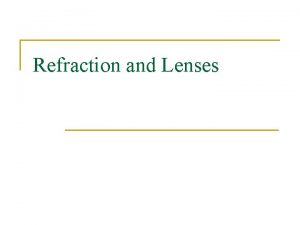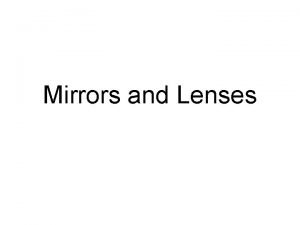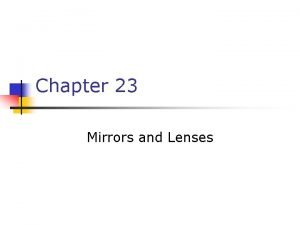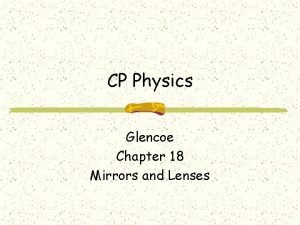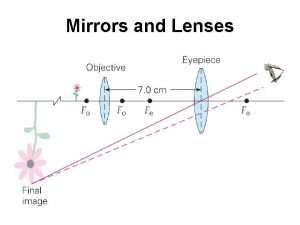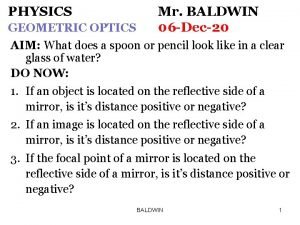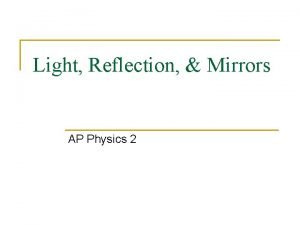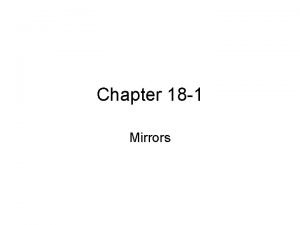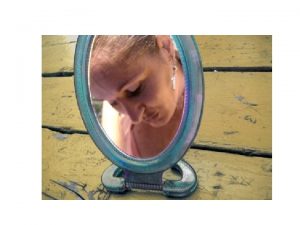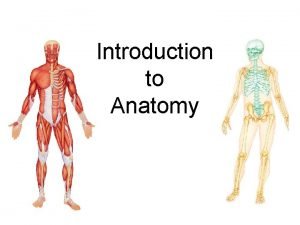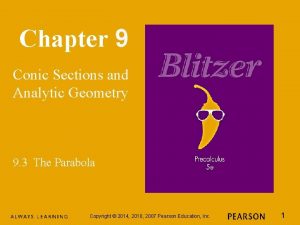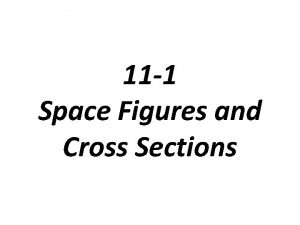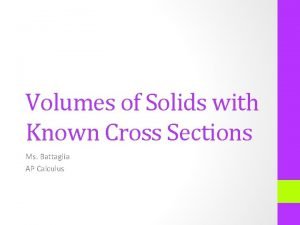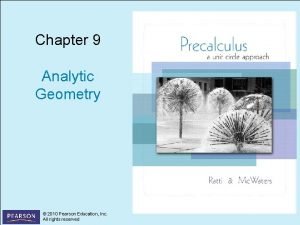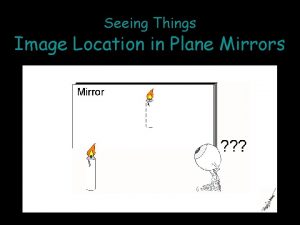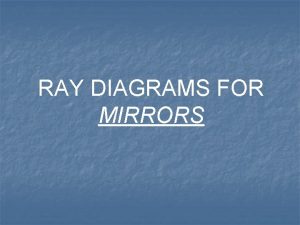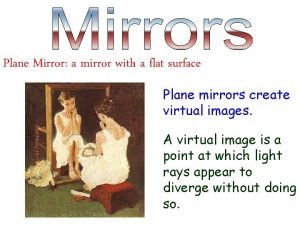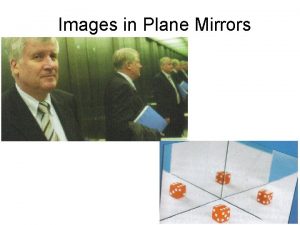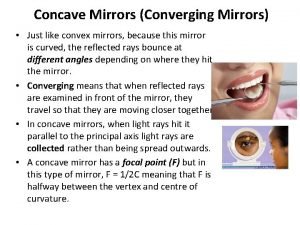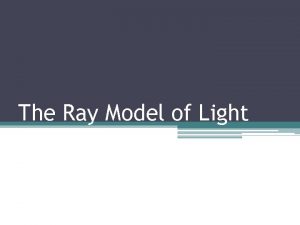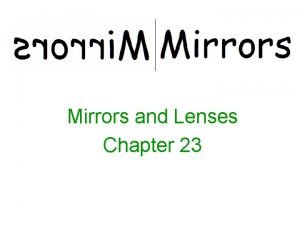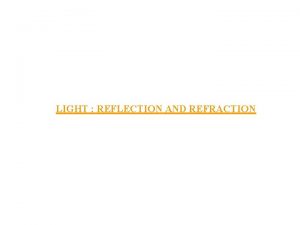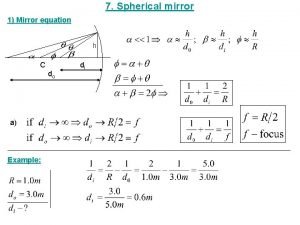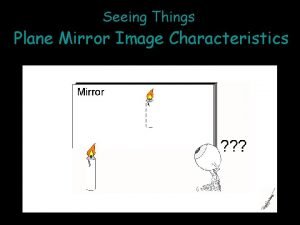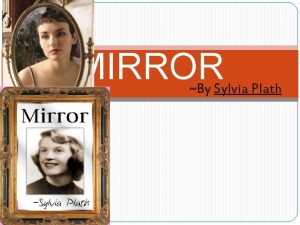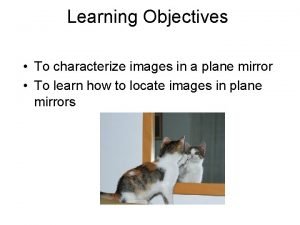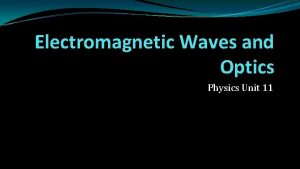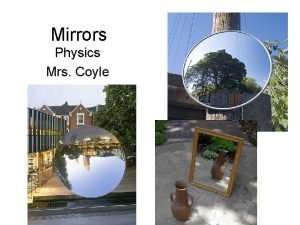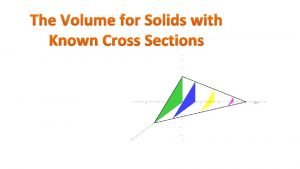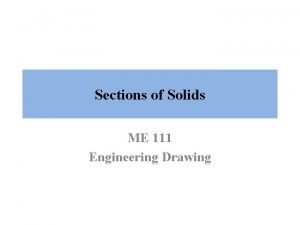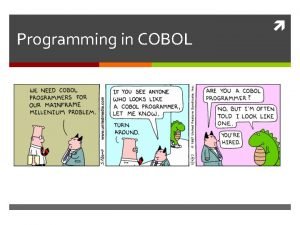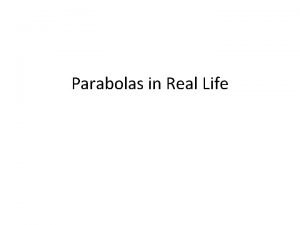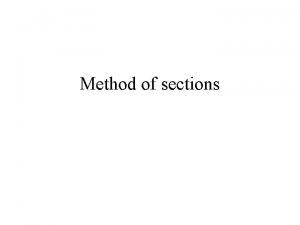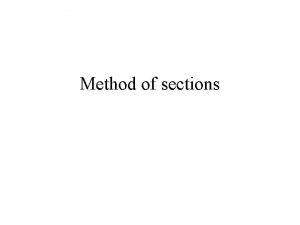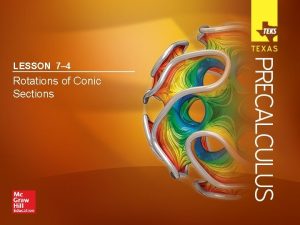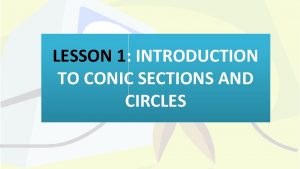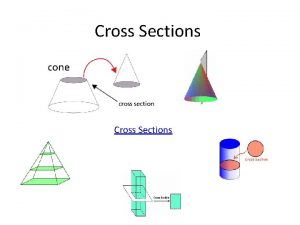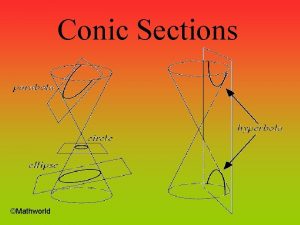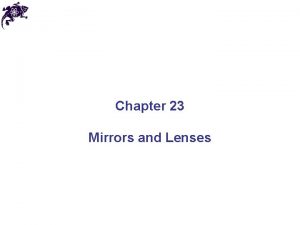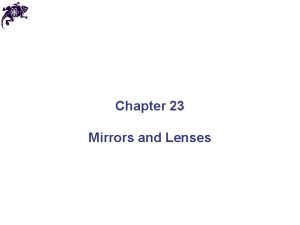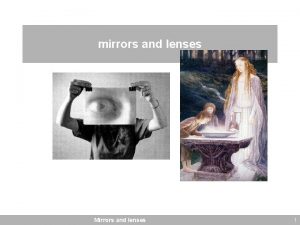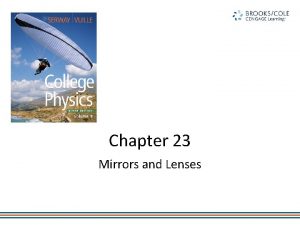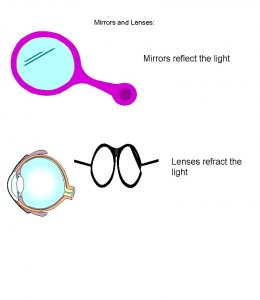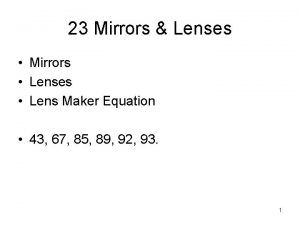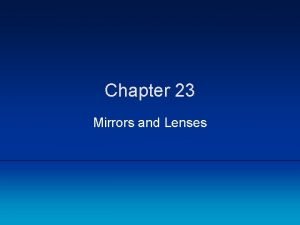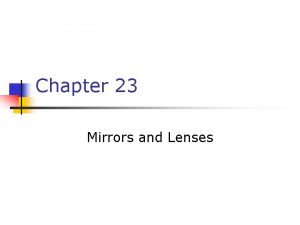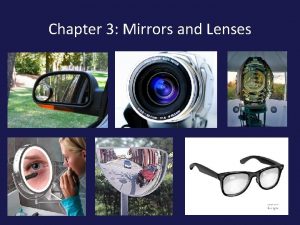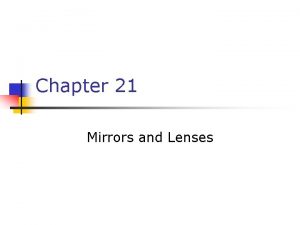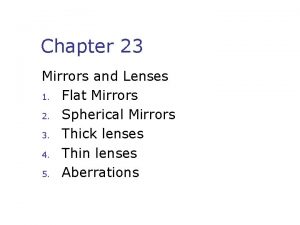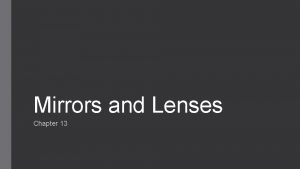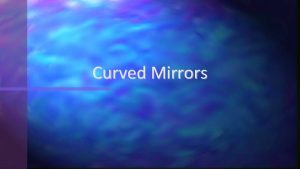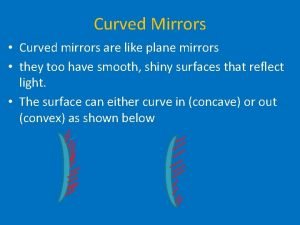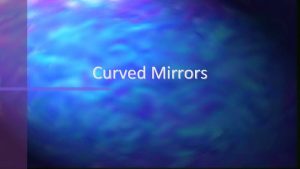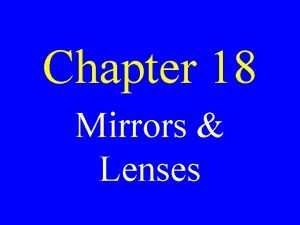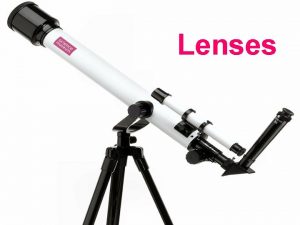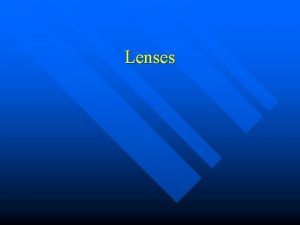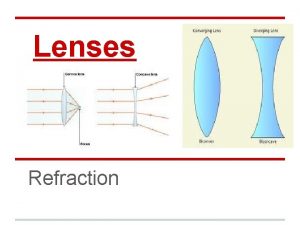Mirrors and Lenses Mirrors and Lenses Sections 1




































































- Slides: 68

Mirrors and Lenses

Mirrors and Lenses Sections 1 -4 Flat Mirrors Images Formed by Spherical Mirrors Concave Mirrors and Sign Conventions Thin Lenses

Flat Mirrors The image formed by a plane mirror is upright, identical in size to the object, and as far behind the mirror as the object is in front of it.

Flat Mirrors The magnification is given by: For a plane mirror, M = +1.

Flat Mirrors What length is required for a full length mirror? B A

Flat Mirrors Multiple Images

Flat Mirrors Multiple Images

Images Formed by Spherical Mirrors A spherical mirror is a section of a sphere. It may be concave or convex.

Images Formed by Spherical Mirrors Concave Mirror Principle Focal Point

Mirrors and Lenses A light ray, traveling parallel to a concave mirror's axis, strikes the mirror's surface near its midpoint. After reflection, this ray (A) again travels parallel to the mirror's axis. (B) travels at right angles to the mirror's axis. (C) passes through the mirror's center of curvature. (D) passes through the mirror's focal point.

Images Formed by Spherical Mirrors Concave Mirror Light Source at the Focal Point Produces Parallel Rays of Light

Mirrors and Lenses A light ray, traveling obliquely to a concave mirror's surface, crosses the axis at the mirror's focal point before striking the mirror's surface. After reflection, this ray (A) travels parallel to the mirror's axis. (B) travels at right angles to the mirror's axis. (C) passes through the mirror's center of curvature. (D) passes through the mirror's focal point.

Images Formed by Spherical Mirrors We use ray diagrams to determine where an image will be. For mirrors, we use three key rays, all of which begin on the object: 1. A ray parallel to the axis; after reflection it passes through the focal point 2. A ray through the focal point; after reflection it is parallel to the axis 3. A ray perpendicular to the mirror; it reflects back on itself

Images Formed by Spherical Mirrors

Images Formed by Spherical Mirrors Concave Mirror Real Image

Images Formed by Spherical Mirrors For a concave mirror, the type of image formed depends on the position of the object.

Images Formed by Spherical Mirrors Concave Mirror Virtual Image





Images Formed by Spherical Mirrors The spherical-mirror equation is valid for any object position: Magnification:

Mirrors and Lenses A object is placed between a concave mirror and its focal point. The image formed is (A) virtual and inverted. (B) virtual and erect. (C) real and erect. (D) real and inverted.

Images Formed by Spherical Mirrors (Problem) A 2. 2 cm object is placed 15. 0 cm from a concave mirror with a radius of 25. 0 cm. (work on board) A) Where is the image located? B) What is its height? di = 75 cm h = -11 cm

Images Formed by Spherical Mirrors (Problem) A mirror at an amusement park shows an upright image of any person who stands 1. 4 m in front of it. If the image is three times the person’s height, what is the radius of curvature?

Mirrors and Lenses A light ray, traveling obliquely to a concave mirror's axis, crosses the axis at the mirror's center of curvature before striking the mirror's surface. After reflection, this ray (A) travels parallel to the mirror's axis. (B) travels at right angles to the mirror's axis. (C) passes through the mirror's center of curvature. (D) passes through the mirror's focal point.

Mirrors and Lenses If you stand in front of a concave mirror, exactly at its focal point, (A) you will see your image at your same height. (B) you won't see your image because there is none. (C) you will see your image, and you will appear smaller. (D) you will see your image and you will appear larger.

Images Formed by Spherical Mirrors Convex Mirror

Images Formed by Spherical Mirrors Convex Mirror Image will always be virtual do di f

Mirrors and Lenses If you stand in front of a convex mirror, at the same distance from it as its radius of curvature, (A) you won't see your image because there is none. (B) you will see your image at your same height. (C) you will see your image and you will appear smaller. (D) you will see your image and you will appear larger.

Mirrors and Lenses A single convex spherical mirror produces an image which is (A) always virtual. (B) always real. (C) real only if the object distance is less than f. (D) real only if the object distance is greater than f.


Images Formed by Spherical Mirrors

Images Formed by Spherical Mirrors Problem Solving: Spherical Mirrors 1. Draw a ray diagram; the image is where the rays intersect. 2. Apply the mirror and magnification equations. 3. Sign conventions: if the object, image, or focal point is on the reflective side of the mirror, its distance is positive, and negative otherwise. Magnification is positive if image is upright, negative otherwise. 4. Check that your solution agrees with the ray diagram.

Images Formed by Spherical Mirrors (Problem) A convex mirror (C = 90 cm) is used in your rearview mirror. Another car is 15 m from the mirror. (work on board) A) Where is the image located? B) What is its magnification? di = -0. 437 m M = 0. 0291 DOT requires C b/w 89 -165 cm

Thin Lenses Thin lenses are those whose thickness is small compared to their radius of curvature. They may be either converging (a) or diverging (b).

Mirrors and Lenses that are thicker at the center (A) spread out light rays. (B) bend light rays to a point beyond the lens. (C) have no effect on light rays. (D) reflect light rays back.

Thin Lenses Double Convex Lens Focal Point

Chapter 23 Mirrors and Lenses A light ray, traveling parallel to the axis of a convex thin lens, strikes the lens near its midpoint. After traveling through the lens, this ray emerges traveling obliquely to the axis of the lens (A) such that it never crosses the axis. (B) crossing the axis at a point equal to twice the focal length. (C) passing between the lens and its focal point. (D) passing through its focal point.

Thin Lenses Ray tracing for thin lenses is similar to that for mirrors. We have three key rays: 1. This ray comes in parallel to the axis and exits through the focal point. 2. This ray comes in through the focal point and exits parallel to the axis. 3. This ray goes through the center of the lens and is undeflected.

Thin Lenses

Thin Lenses Double Convex Lens Real Image






Thin Lenses For a diverging lens, we can use the same three rays; the image is upright and virtual.

Thin Lenses Concave Lens Virtual Focal Point


Thin Lenses

Thin Lenses The thin-lens equation: Magnification: Power: Lens power is measured in diopters, D. 1 D = 1 m-1

Thin Lenses Double Convex Lens

Mirrors and Lenses A convex lens has a focal length f. An object is placed between f and 2 f on the axis. The image formed is located (A) at 2 f. (B) between f and 2 f. (C) at f. (D) at a distance greater than 2 f from the lens.

Thin Lenses (Problem) A converging lens has a focal length of 20. 0 cm. (work on board) a) Locate the images for object distances of 40. 0 cm, b) Locate the images for object distances of 20. 0 cm. , c) Locate the images for object distances of 10. 0 cm.

Thin Lenses Concave Lens Virtual Image

Mirrors and Lenses The images formed by concave lenses (A) are always real. (B) are always virtual. (C) could be real or virtual; it depends on whether the object distance is smaller or greater than the focal length. (D) could be real or virtual, but always real when the object is placed at the focal point.

Thin Lenses (Problem) An object is placed 8 cm from a 20 cm converging lens. (work on board) A) What is the image distance? B) What is M? C) Type of image (real or virtual)? di = -13. 33 cm M = 1. 67 Virtual

Thin Lenses In lens combinations, the image formed by the first lens becomes the object for the second lens (this is where object distances may be negative).

Review of Chapter • Plane mirrors form virtual, upright, and unmagnified images. • The object distance is equal to the image distance. • The lateral magnification factor for all mirrors and lenses is: • Focal length of a spherical mirror:

Review of Chapter • Spherical-mirror equation: • Thin-lens equation:

homework - 1

Homework - 2

Homework - 3

Homework - 4

homework - 5

homework - 6

 Lenses and mirrors
Lenses and mirrors Mirrors and lenses
Mirrors and lenses Mirrors and lenses
Mirrors and lenses Physics classroom lenses and mirrors
Physics classroom lenses and mirrors Mirror lens equation
Mirror lens equation Sign convention table for mirrors and lenses
Sign convention table for mirrors and lenses Ap physics 2 mirrors and lenses
Ap physics 2 mirrors and lenses Chapter 17 reflection and mirrors
Chapter 17 reflection and mirrors Plane concave and convex mirrors
Plane concave and convex mirrors Reflection and mirrors ppt
Reflection and mirrors ppt Cutaways and cross sections definition
Cutaways and cross sections definition Parietal vs visceral
Parietal vs visceral Anatomy terms
Anatomy terms Chapter 9 conic sections and analytic geometry
Chapter 9 conic sections and analytic geometry 11-1 space figures and cross sections answer key
11-1 space figures and cross sections answer key Health and safety at work act section 2
Health and safety at work act section 2 Graduated commision
Graduated commision Haircutting chapter 16
Haircutting chapter 16 Volumes of solids with known cross sections
Volumes of solids with known cross sections Directional terms planes and sections
Directional terms planes and sections Body planes and sections
Body planes and sections Chapter 7 conic sections and parametric equations
Chapter 7 conic sections and parametric equations Chapter 9 conic sections and analytic geometry
Chapter 9 conic sections and analytic geometry Flat plate collector with adjustable mirrors
Flat plate collector with adjustable mirrors Plane mirror location
Plane mirror location Ray diagrams for mirrors
Ray diagrams for mirrors A mirror with a flat surface is a plane mirror.
A mirror with a flat surface is a plane mirror. Salt convex mirror
Salt convex mirror Properties of image in plane mirror
Properties of image in plane mirror Salt converging lens
Salt converging lens Name the two parts that make up most mirrors.
Name the two parts that make up most mirrors. Elisabetta silli
Elisabetta silli Concave mirrors can produce
Concave mirrors can produce Concave mirrors can produce
Concave mirrors can produce What is the mirror equation
What is the mirror equation Monochromater
Monochromater Synchronous adjustment mirrors
Synchronous adjustment mirrors Salt plane mirror
Salt plane mirror Take a large shining spoon activity
Take a large shining spoon activity Fluffy sky mirror reviews
Fluffy sky mirror reviews I am silver and exact poem
I am silver and exact poem All images in plane mirrors are apex
All images in plane mirrors are apex Physics 11-06 image formation by mirrors
Physics 11-06 image formation by mirrors Mirror in physics
Mirror in physics Solids of known cross sections
Solids of known cross sections Think on these things
Think on these things Declaration of independence sections
Declaration of independence sections Lesson 4 declaring independence
Lesson 4 declaring independence Ich common technical document
Ich common technical document Lymphatic drainage of stomach
Lymphatic drainage of stomach Sectioning of solids in engineering drawing
Sectioning of solids in engineering drawing The sectional plane are represented by
The sectional plane are represented by What is a removed section view
What is a removed section view What is the voice box called
What is the voice box called Cobol sections
Cobol sections Pga sections map
Pga sections map Parabola real life
Parabola real life Method of sections
Method of sections Method of sections
Method of sections Rotating conic sections
Rotating conic sections Lesson 1 exploring conic sections
Lesson 1 exploring conic sections Semicircle cross section formula
Semicircle cross section formula Ellipse conic section examples in real life
Ellipse conic section examples in real life Green section of emergency response guidebook
Green section of emergency response guidebook Cross section slice
Cross section slice Parallel cross section of a sphere
Parallel cross section of a sphere Parabola vs hyperbola
Parabola vs hyperbola Conic sections definition
Conic sections definition Conic sections
Conic sections
